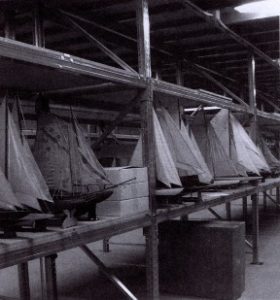The reduction in inventory reveals unresolved problems in the supply chain
by Armin Klüttgen, Herzogenrath
Inventory reduction projects are being tackled with great vigor and the best of intentions in many places. The route set by management is usually: 98% delivery efficiency with a simultaneous 25% reduction in stocks. This is rightly called increasing profitability and customer satisfaction at a first-class price/performance ratio. These goals can always be achieved with a great deal of effort to optimally adjust scheduling. The project participants are proud of the goals they have achieved: “We are now lean and customer-oriented and have increased our liquidity at the same time.” The best prospects for the fierce battle in the tough competition.
First disillusionment

However, after the completion of such projects and the initial euphoria about the successes achieved, disillusionment is not too long in coming in the absence of holistic project management. Inventory levels sometimes return after just a few months, stock turnover falls back towards the old level and the targeted delivery readiness, to which all inventory management parameters were tailored, does not materialize in line with the forecast potential. So there is no trace of sustainability. Did this project make any sense at all? You can’t keep repeating this elaborate procedure! Does this mean that stock reduction projects are a flash in the pan and ultimately impractical? We are often called to companies that have previously tried in vain to reduce their inventories with an internal team. An analysis of the interrelationships in such projects reveals the real problems of unsuccessful attempts to reduce stocks.
The real problem
Inventory management projects can only be successful if the disruptive factors in the supply chain itself are also attacked, as these are often the triggers for a renewed build-up of inventory. The inventory masks many problems relating to scrap production, supplier performance, a lack of flexibility in the face of changing market requirements, inadequate production planning and control and the management of processes that are prone to disruption because the company is always ready to deliver. In this respect, lowering the inventory level must be understood as unmasking the problems that need to be tackled. They must not simply be cosmetically covered over again with stocks! In practice, however, the symptoms are often treated rather than tackling the causes.
Lowering the inventory level unmasks the problems that need to be tackled! A sustainable reduction in inventory and an increase in delivery readiness are only possible if the weak points in the supply chain that have become apparent after inventory reduction projects are not plastered over again, but eliminated. Otherwise, many efforts are wasted.
- Suppliers deliver too late, too little, too poor quality.
- There are restrictions on the procurement of input material (e.g. only a limited number of qualified routes).
- Delivery concepts (delivery frequency, quantity, order lead time, minimum order quantities, etc.) prevent a low-stock solution. -> Acyclical purchasing of materials that are highly volatile in terms of price causes alternating supply availability and inventory problems.
One company in the luxury goods industry recorded a rate of 10-20, in some cases even up to 50%, of unusable parts for some of its externally procured materials. If permitted by quality assurance, these are revised, which increases the throughput time. The rest of the parts are sent back to the suppliers and are therefore not used for restocking purposes. In addition, this uncertainty is overlaid by delivery date deviations, which can be considerable.
Problems in production
- What was planned to be produced is not produced.
- Fault-prone processes (for example in the metal industry) are “made safer” by building up stocks behind the unstable production stage.
- Process engineering constraints lead to a forced flow of material into production, predetermined production sequences and campaign formation generate undesirable inventory effects.
In an assembly manufacturing company, the foremen in production overrode all planning specifications by combining orders on their own responsibility for reasons of “economic efficiency” and “throughput optimization” in order to achieve batch size optimization. In addition, predefined sequences and campaign formations were also overridden in the scheduling. Unfortunately, the idea that a batch size has to be large is still very much alive everywhere. However, this view is one-sidedly focused on the efficiency of production or, in many cases, just a single production step. It does not have a view of the overall optimum.
Committees (planned and unplanned scrap) are also a sensitive element, as they are not or only inadequately involved in the planning process. However, rejects that are not properly planned are the killer for a high level of delivery readiness. Realistic planning is therefore also necessary here in particular.
Problems in sales
- The sales department maintains its own buffers. The premature loading of orders or the use of “dummy orders”, which occupy capacities and allocate primary material, are popular ways of doing this.
- The accuracy of sales planning is inadequate and the integration of different, hierarchically organized planning levels is not consistently pursued.
- In the case of cross-location production, a lack of coordination and synchronization at the interfaces between companies leads to delivery problems.
In a company in the metal industry, the sales department used various means to generate an additional stock range of approx. 1 week. They officially worked with an internal and an external target date in order to be able to meet the tough external deadlines. The roots of this system lay in a time when production was not performing well enough and the sales department had lost confidence in the delivery readiness of its own production. The result was more stock and multiple daily telephone calls from the sales department trying to intervene in production planning.
Generic problems
Regardless of these individual aspects and the seemingly hair-raising anecdotes from daily practice, two problems in the planning and control of inventories and delivery readiness ultimately lay claim to having found the widest distribution across all sectors:
- Insufficient data quality, completeness and interpretation
- Master and transaction data are incorrect or incomplete, are not adequately maintained and are interpreted differently.
- In heterogeneous IT landscapes, individual stand-alone solutions are used that are not consistent with each other in terms of content and are not always up to date.
- Lack of portfolio transparency
- Many companies often fail to answer the question of how much stock they have. But you can only improve what you know.
Conclusion
If you do not want to pay the price of high stock levels and poor delivery readiness (permanently), it is important to attack the disruptions that occur as much as possible after or during an inventory reduction project. Where there is no degree of freedom in this respect or the measures have not yet been completed, they must be taken into account in planning.
- Suppliers should be qualified, but at the same time existing deficiencies in on-time delivery or in the quality delivered should be taken into account in planning through delivery safety stocks. These stocks can then be reduced again as supplier qualification progresses.
- Reject rates in production should give the OS and process engineering cause for action, but at the same time be planned accordingly and reduced with increasing improvement.
- Campaign planning, batch sizes and set-up sequences should be put to the test. The effects of different parameters are often misjudged here.
- Last but not least, many companies would benefit considerably from a “data quality and availability initiative”.
For inventory reduction projects, it is often not sufficient to carry out an isolated parameter optimization that is decoupled from the supply chain in order to fully exploit the great optimization potential. The close interlinking of processes and structures within the supply chain makes it essential to look beyond the end of one’s nose and take a holistic approach to achieving delivery readiness while minimizing inventories. This makes it possible to make inventory reductions sustainable, fully realize existing potential and also lay the foundations for a continuous improvement process.

